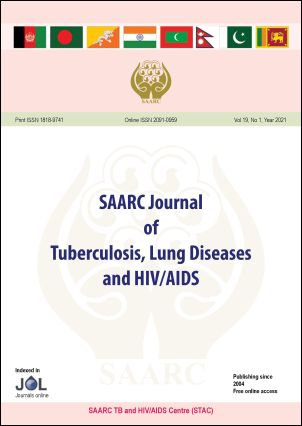Comparison of CD4 and CD8 Counts in HIV negative Pulmonary Tuberculosis Patients with Normal Healthy Controls in and around Prayagraj
DOI:
https://doi.org/10.3126/saarctb.v19i1.39949Keywords:
CBNAAT,, Pulmonary tuberculosis, CD4 count, ELISAAbstract
Anti-tuberculosis immunity involves a cellular immune response for their control. A critical marker of immunologic integrity is the CD4 and CD8 cell counts. Tuberculosis may be a cause of non-HIV associated CD4 and CD8-T cell lymphopenia. This study compares mean CD4, CD8 cell count and CD4:CD8 Ratio in pulmonary tuberculosis patients never had treatment for tuberculosis, pulmonary tuberculosis patients had received anti-tuberculosis treatment for more than one month and normal healthy controls. A case control study done in Prayagraj from October 2019 to October 2020 includes HIV negative, sputum positive pulmonary tuberculosis patients never had treatment for tuberculosis(n=25), pulmonary tuberculosis patients had received anti-tuberculosis treatment for more than one month(n=24), and normal healthy controls(n=36). We collected details including age, sex, symptoms of pulmonary tuberculosis, anti-tuberculosis treatment and investigated for HIV testing by ELISA, Sputum for AFB, Sputum for CBNAAT, CD4 and CD8 cell count determined by flow cytometrically.
The mean CD4 and CD8 cell count was significantly lower in HIV negative pulmonary tuberculosis patients never had treatment for tuberculosis than in normal healthy controls (p value<0.001) and CD4:CD8 ratio also lower (p value=0.013). The mean CD4 and CD8 cell count higher in pulmonary tuberculosis patients who have received anti-tuberculosis treatment for more than one month than in pulmonary tuberculosis patients never had treatment for tuberculosis (p value<0.001) and CD4:CD8 ratio also higher (p value=0.013). CD4 and CD8 lymphopenia is an acceptable phenomenon in HIV negative pulmonary tuberculosis patients and such lymphopenia improves with anti-tuberculosis drug regimens as per protocol. This study highlights the importance of CD4, CD8 cellular immune response conducted by T- lymphocytes in outcome of pulmonary tuberculosis.
Downloads
Downloads
Published
How to Cite
Issue
Section
License
Copyright © SAARC Tuberculosis and HIV/AIDS Centre (STAC), all rights reserved, no part of this publication may be reproduced, stored in a retrieval system or transmitted in any form or by any means without prior permission of the STAC.





